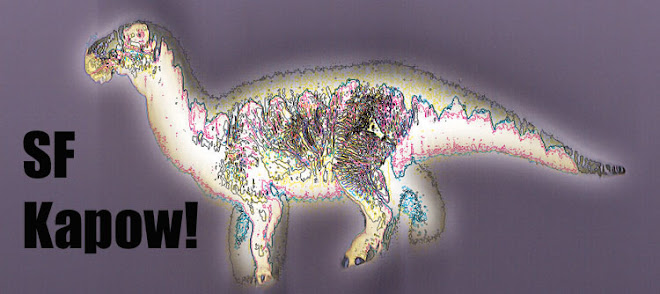It's good, at least so far. It's the tale of Muire, last of the valkyries (or, by the text's tongue-mangling spelling, the waelcyrge) aka the Children of Light. In the opening chapters, the world ends, as the Children of Light face off against evil wolf things and their own wayward kin, in something that's near enough to Ragnarok. Only Muire, a steed called Kasimir, and one traitor and evildoer, the Grey Wolf, are left alive.
Then the story jumps 2,300 years in the future. The world's ending again.
That's a hell of a hook for any story. The story is most notable so far for mixing pulp SF, Lovecraft, Wagnerian pseudo-Norse mythology, and steampunk into a thick gumbo of weirdness.
Here's a sample, from a flashback as Muire begins to understand that the humans who have inherited the world from the gods are headed for their own apocalypse:
The tears that choked her breathing weren't from the wasp's futile venom. They came because she could no longer deny what she knew. Cascading catastrophe, the system in failure. It was not Muire's first apocalypse. But then, her kind had always been better at retribution than prevention.This is some weird stuff. Kasimir, the valkyrie's mount, is a two headed deer-like winged creature. Horribly wounded, at the start of the story he is restored into a magical steampunk cyborg by one of the last miracles of the Children of Light.
And she knew as if it had been blazoned on a banner, with desperation would come war.
Black sorcery, radiation weapons, nanites, railguns, orbital assault, biotoxins and all the ills the flesh is heir to: Valdygard had died its first death in ice. The second was in flames. Mountains were heaved up and pounded flat. Oceans steamed and cities died in silence, suffocated under falling dust.
Eiledon... was spared.
So we've got ancient demigods, future technology, animal-human hybrids, cyborgs, killer cyborg flying reindeer/antelopes... it reminds me of Rifts.
Ah, Rifts, uber-nerdy game of my early teenage years. And some of my later teenage years. But hardly any of my twenties, I swear to god! Rifts, for those who decline to link, is the everything-but-the-kitchen-sink pen and paper RPG. Created in the 1990s, it it set on a future earth wracked by both nuclear and magical holocausts, it includes cyborgs, giant robots, monsters, demons, elves, dwarves (and the whole Tolkeinian pantheon of near-humans) dragons, psychics, evil empires, Cthulhu critters, Atlantis, dinosaurs, vampires... I could just keep listing elements for line after line here.
Rifts, however, and the entire Palladium Games line, are mostly notable for being of fairly mediocre quality. The game system is antiquated by modern standards, the rules are cumbersome, character generation takes forever, and the books themselves are often marred by writing that's clumsy to downright bad. Throw in at least one or two proofreading errors in every book and you've got yourself a bargain basement games line, that survives on the sheer balls to the wall fun of its concept. Yes, you can be an elven commando who fights vampires with his cyborg dwarf buddy! Or you can be an Atlantean with magic tattoos, or a talking mutant dog with psychic powers!
A lot of folks are doubtless going to label the book part of the New Weird movement, but I can't help but wonder if this mashup of fantasy and SF is just going to become mainstream in the future. To understand either All the Windwracked Stars or Rifts, you have to be immersed in SF and fantasy. It makes no sense outside a cultural context that includes Tolkein and Wagner and H.P. Lovecraft and Star Wars. That sphere, the nerdsphere if you will, has been expanding like a young universe for the last thirty years. Everyone has a passing acquaintance with it, many of us are deeply immersed. So Bear's book offers us, as the Norse would have it, kennings. Like barbarians around a campfire, she has but to mention a shoggoth, or an animal-human hybrid moreaux, and we know this to be an offhand reference to another tale, another saga for nerdkind. And we nod our heads in appreciation. Truly, this bard knows the old tales well.
Bear, like the makers of Rifts, has all the pieces to play with. What she does with it is what will distinguish her from the others who try this sort of hybridization. So far, I'm enjoying it immensely.

No comments:
Post a Comment